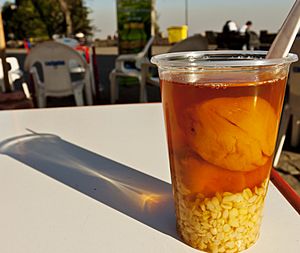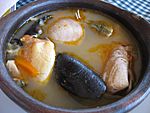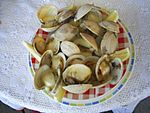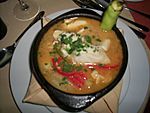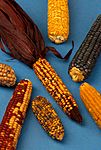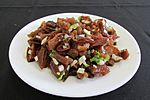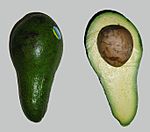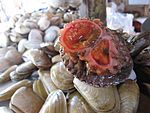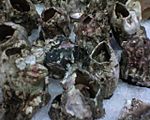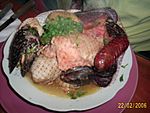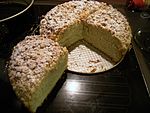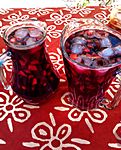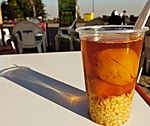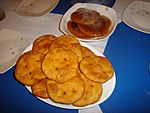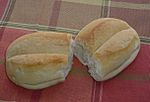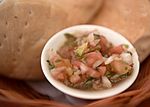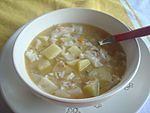Chilean cuisine facts for kids
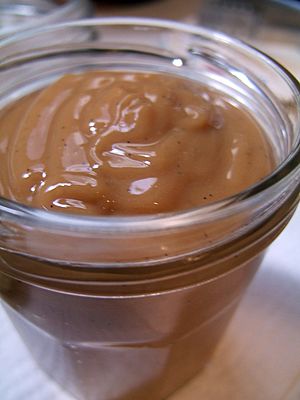
Chilean food is a delicious mix of old traditions and new ideas. It brings together flavors from Spanish cuisine, the native Mapuche culture, and local ingredients. Later, influences from countries like Germany, the United Kingdom, and France added even more variety.
Chile's amazing geography and climate mean there are many different fruits, vegetables, and farm products. The long coastline and the Pacific Ocean provide a huge amount of seafood. Unique fish, shellfish, and even algae thrive in the oxygen-rich waters of the Humboldt Current. Chile is also famous for its wine, which often goes perfectly with local dishes. Did you know that the sweet treat called dulce de leche, or manjar in Chile, was invented here? It's one of Chile's most famous food gifts to the world!
Contents
History of Chilean Food
Chilean cuisine has a long and interesting history. It all started when Spanish explorers arrived in 1540. They brought new foods like wheat, pigs, sheep, cattle, chickens, and wine. The native people, in turn, shared their own important foods: potatoes, maize (corn), beans, and seafood. Many classic Chilean dishes today are made from these basic ingredients mixed together.
In colonial times, people enjoyed dishes like chuchoca (dried corn) and humitas (corn paste wrapped in husks). Meals were often big and hearty. Lunch was the main meal, usually starting with fish or meat, followed by a stew called guiso with fresh corn and potatoes. For dessert, people ate fruits like strawberries and lucumas.
In the 1600s, nuns in convents became famous for their delicious pastries. This led to a Chilean saying, "s/he has the hands of a nun," meaning someone is a great cook! During this time, geese and turkeys arrived from Mexico, and melons and watermelons came from Jamaica.
By the 1700s, Chilean food became more fancy, especially for wealthy families. Tea and coffee started to replace mate, and Chilean wine became very popular. People also began drinking chicha, a sweet wine made from fermented grapes or apples.
When Chile gained its independence, people celebrated with empanadas, chicha, and red wine. These foods are still a big part of independence day celebrations today!
New Flavors from Immigrants
In the 1800s, Chile started to develop its own unique identity, and food was a big part of this. The government encouraged people from other countries to move to Chile. This brought many new flavors!
German immigrants, especially in the south, had a huge impact. They introduced pork dishes, sausages, and delicious pastries. Today, you can find Berliners (a type of doughnut) and kuchen (German cakes) in bakeries all over Chile.
Italian immigrants brought pasta and different meat products. In towns like Capitán Pastene, they still make prosciutto (cured ham) the same way the first Italian families did.
In the 1900s, French culture strongly influenced Chilean food. French cooking styles and techniques became popular. For example, the omelette became more common than the traditional Spanish tortilla. Along with French, Italian, and German people, immigrants from Croatia, Greece, Palestine, Belgium, and the Basque region also added to Chile's food traditions.
Today, Chile is a modern country with a growing food scene. This means more exciting restaurants and food experiences for everyone!
-
Asado Chileno
-
Paila marina, a seafood soup
-
Caldillo de congrio, a fish soup
Main Crops and Products
Chile's unique geography, climate, and geology allow for many different types of farming. While farming is not as big a part of Chile's economy as it used to be, it still produces many important foods. Some of the main crops include grapes, apples, pears, onions, wheat, maize, oats, peaches, garlic, asparagus, and beans. Chile also produces beef, poultry, wool, fish, and timber.
Foods from the Americas
- Cherimoya: This sweet fruit comes from the Andes mountains. It is very popular in Chile.
- Maize (Choclo): Known as choclo in Chile and Peru, this corn was a main food for ancient civilizations like the Maya, Aztecs, and Incas. Chilean choclo has very large kernels and a savory, nutty flavor.
- Lúcuma: Another fruit from the Andes, lúcuma is very healthy. It's often used to flavor desserts and ice cream around the world.
- Murta or Murtilla: This small berry is native to southern Chile. The Mapuche people used it long ago. It's great for making jams and liquor.
- Potato: Potatoes are a key ingredient in many Chilean dishes, like cazuela. They are a basic food in Chile.
- Quinoa: This healthy grain has been an important food in the Andes for 6,000 years. It's grown in parts of Chile like Concepción and Temuco.
- Nalca or pangue: This plant, similar to rhubarb, grows in southern Chile. Its leaves are used in curanto, and the stems can be eaten in salads or preserves.
- Avocado (Palta): Called palta in Chile, avocados have been eaten here since ancient times. The Chilean variety is known as Negra de la Cruz.
- Aji verde (green chili): This is a common type of green chili pepper in Chile. It's eaten before it fully ripens.
Fish and Seafood
Chile's long coastline means its cuisine has a huge variety of delicious fish and seafood. The Humboldt Current brings many different species to Chilean waters.
Popular Fish
- Soleidae (Sole)
- Albacore
- Codfish
- Hake (Merluza)
- Sciaenidae (Corvina)
- Salmon
- Tuna
- Jurel
- Reineta
- Congrio (Conger eel)
- Patagonian toothfish (Lubina)
- Swordfish
Popular Seafood
- Abalone
- Macha (a type of razor clam)
- Prawn
- Choros (mussels)
- Clam
- Centolla Chilena (Southern King Crab)
- Crab (Jaiba)
- Shrimp
- Oyster
- Lobster
- Langosta de Juan Fernández (Juan Fernández Island lobsters)
- Locos (Chilean abalone)
- Picorocos (barnacles)
- Pyura chilensis (Piure)
- Squid (Jibia)
- Sea urchin (Erizo)
-
Pyura chilensis (Piure) on machas
-
Chorito (Chilean mussel)
-
A Pacific razor clam similar to Chilean Machas
Food from Northern Chile
The food in northern Chile is strongly influenced by the Aymara, Diaguita, and Atacameño cultures, as well as the coastal Chango people. Their diet traditionally includes a lot of protein.
They often use root vegetables like apilla or oca and ulluco, which are not common in central or southern Chile. Traditional northern Chilean food also uses meat from camel-like animals such as llama and alpaca. Dishes like chairo have been made for centuries by Andean cultures.
Northern Chilean Dishes
- Asado: Meat roasted on a barbecue. In the north, you might find asados made with alpaca meat.
- Charqui: Dried and salted meat, often from llama.
- Machas a la parmesana: Razor clams cooked in the oven with Parmesan cheese. This is a popular appetizer.
- Erizos con salsa verde: Sea urchins eaten raw with lemon, herbs, and onion.
- Caldillo de congrio: A fish stew with conger eel and vegetables.
- Plateada con quinoa: A beef cut cooked with quinoa, onions, garlic, and white wine.
- Cazuela marina: A stew with different types of seafood and vegetables.
- Ensalada chilena nortina: A salad of onions and tomatoes, similar to the basic Chilean salad, but with goat cheese and olives.
Food from Central Chile
The food in central Chile is a mix of native traditions and European influences, especially from the late 1800s. Farm life and agriculture have always been very important here. Many country traditions still exist, and food is a great example of this.
Central Chilean Dishes
- Locos con mayonesa: Locos (Chilean abalone) served with mayonnaise, lettuce, and potato salad.
- Palta reina: Avocado halves stuffed with chicken salad, tuna, or prawns.
- Pastel de choclo: A delicious layered pie. It has a bottom layer of ground beef, chicken, olives, and a hard-boiled egg. The top is a creamy mix of fresh corn and basil, baked until golden.
- Humitas: Similar to Mexican tamales, these are made from fresh, ground corn baked inside corn husks.
- Porotos granados: A stew made with fresh white beans, ground fresh corn, and other vegetables.
- Empanadas fritas de queso: Empanadas filled with cheese and deep-fried.
- Charquican: A stew made with dried beef or regular beef, potatoes, corn, and other vegetables.
- Pastel de papa: A pie with a bottom layer of minced beef and a top layer of mashed potatoes, similar to a cottage pie.
- Pan de Pascua: A sweet sponge cake, usually eaten at Christmas. It has ginger, cinnamon, liquor, honey, candied fruits, raisins, walnuts, and almonds.
- Pan amasado: A traditional bread made with animal fat, kneaded for a long time to make it dense.
- Leche asada: A baked milk dessert with caramel, similar to panna cotta.
Food from Southern Chile
Southern Chilean food has been greatly influenced by Mapuche cuisine and the food from the Chiloé Archipelago. Two special products from this region are the Merkén spice and the Kollongka or Mapuche chicken, known for its unusual blue-green eggs.
German immigrants in the 1800s also had a big impact. Many traditional German cakes and desserts are now popular throughout Chile.
Like the rest of Chile, seafood is very important here. But because the south has thousands of islands, the ocean plays an even bigger role in the diet.
-
Kuchen, a traditional Chilean cake from German migrants
Southern Chilean Dishes
- Merkén: A traditional Mapuche spice made from dried and smoked red chilies and coriander. It's used to flavor many dishes.
- Araucana Chicken: These chickens, native to southern Chile, lay light blue or green eggs.
- Chupe de locos: A rich stew made with Chilean abalone, served with bread and baked in clay pots.
- Asado al palo: A way of cooking meat where a whole animal (usually lamb) is roasted on a stick over a large wood fire for hours until it's very tender.
- Curanto: A traditional meal where seafood and meat are cooked in a large hole in the ground using heated stones.
- Pulmay: A type of curanto cooked in a big pot instead of a hole in the ground.
- Chapalele: A Chilean dumpling made from boiled potatoes and wheat flour.
- Crudos: A German-Chilean dish similar to steak tartare, made with raw meat.
- Milcao: A potato pancake made with raw grated potatoes and cooked mashed potatoes.
- Valdiviano: One of the oldest Chilean dishes, named after the explorer Pedro de Valdivia. This soup, made of dried meat, onions, and potatoes, was eaten by Spanish soldiers.
Baked Goods, Desserts, and Breads
- Brazo de Reina: A classic Swiss Roll, usually filled with strawberry jam, raspberry jam, or manjar (Chilean dulce de leche).
- Kuchen: Traditional German cakes filled with seasonal fruits like strawberries, blackberries, or peaches.
- Sopaipillas: Deep-fried dough. They can be plain or made with pumpkin. They are eaten sweet with sugar or caramel sauce, or savory with chili sauce.
Beverages
- Chicha de manzana: A fermented apple cider.
- Muday: An alcoholic drink made from corn, wheat, or piñón (pine nuts).
- Murtado: A liquor made by soaking murta berries in aguardiente (a strong spirit).
Other Chilean Dishes
Easter Island (Rapa Nui) Food
Food on Easter Island mixes Chilean and Polynesian styles. It features more types of fish than mainland Chile, plus unique fruits and root vegetables.
- Ceviche: Can be made with soy or coconut milk, and different local fish like tuna.
- Po`e: A cake made from banana or cassava.
- Umu Rapa Nui: Easter Island's version of curanto.
Drinks
Chile's climate is perfect for growing grapes, making it one of the world's biggest wine producers. But wine isn't the only popular drink!
- Borgoña (drink): Cold red wine with chopped strawberries and sugar.
- Chicha: A sweet fermented wine, often from grapes or apples. Popular during independence day celebrations.
- Chilean Aguardiente: A strong spirit made from distilled grape leftovers, similar to Italian grappa.
- Cola de mono: A traditional Chilean Christmas drink, like eggnog. It's creamy and tastes a bit like a White Russian.
- Melon con Vino: A honeydew melon (called Melon Tuna) with the top cut off, filled with ice and wine.
- Navegado: Warm red wine with orange slices and sugar, similar to mulled wine.
- Piscola: Pisco (a type of brandy) mixed with cola and ice.
- Ponche a la Romana: Champagne with pineapple ice cream, often served on New Year's Eve.
- Terremoto (Earthquake): Vino pipeño (a sweet wine) with pineapple ice cream, served in a large glass. A smaller second glass is called a Replica (aftershock).
- Non-alcoholic drinks
- Mote con huesillo: A popular drink made with cooked dried peaches and husked wheat. It can also be a dessert.
Sandwiches and Chilean Fast Food
Besides global fast-food chains, Chile has its own traditional "fast food." Empanadas are a quick and tasty meal. Chilean hot dogs are more complex than regular ones, often topped with mashed avocado, chopped tomatoes, sauerkraut, and homemade mayonnaise. In winter, Sopaipillas are a popular street snack.
- Barros Jarpa: Grilled cheese and ham on a white bun.
- Barros Luco: Grilled cheese and meat on white bread.
- Churrasco Italiano: A beef sandwich with tomato, avocado, and mayonnaise. It's named after the colors of the Italian flag (red, white, green).
- Chacarero: Like the churrasco, but with green beans and tomatoes.
- Completo: A hot dog with tomato, avocado, salsa americana (a mix of pickles, carrots, and onion), and sauerkraut.
- Italiano: A hot dog with tomato, avocado, and mayonnaise.
- Lomito Alemán: A pork sandwich with tomatoes, mayonnaise, and sauerkraut.
-
Sopaipillas, in background with chancaca
-
Completo italiano (Chilean hotdog)
-
Chacarero, a popular sandwich
Starters and Salads
- Ensalada Chilena: A simple salad of sliced tomatoes and onions.
- Palta reina: Stuffed avocado.
- Tomates rellenos: Stuffed tomatoes.
Cereals and Legumes
Beans, lentils, and chickpeas have been important in Chilean food since before colonial times. They are often cooked with rice, fresh corn, or even pasta.
- Porotos con riendas: A stew of beans and spaghetti.
- Porotos Granados: Fresh beans and ground fresh corn.
- Lentejas con arroz: A stew of lentils and rice, often with longaniza (sausage).
- Arroz graneado: Rice is a very popular side dish. In Chile, it's usually fried with garlic and carrots.
Pasta
Pasta is common in Chilean meals. It's prepared similarly to other countries, but some names and shapes might be different. Tomato-based, white (béchamel), and cream sauces are the most common.
Tortillas
- Panqueques: Crepes, often eaten with manjar, but can also be a main course with vegetables.
- Tortilla: A basic flour and egg tortilla that can be mixed with potatoes, cauliflower, peas, or seafood.
- Sopaipillas: Can also be described as a type of tortilla.
- Chapalele: A potato and flour dumpling.
- Milcao: A potato pancake.
Empanadas
Empanadas are popular in many cultures, but Chilean ones have special fillings and cooking methods. Sellers always say if they are fried or baked.
- Empanadas: Can be baked (de horno) or fried (fritas).
- Popular fillings include
- Pino (beef and onions)
- Cheese, or ham and cheese
- Seafood (a mix of mussels, clams, and other shellfish)
- Onions (called Empanadas Pequenes)
- Prawns
- Cheese, basil, and tomatoes
Breads
Chileans eat a lot of bread, almost as much as Germans! They eat bread for breakfast, lunch, snacks, or dinner. For the afternoon snack called las onces, bread should be as fresh as possible, ideally still warm from the bakery.
- Marraqueta: A very common bread with a crispy crust and a soft, airy inside. Marraqueta with mashed avocado is a favorite for las onces.
- Hallulla: Another popular type of Chilean bread.
- Pan amasado: A traditional kneaded bread.
- Tortilla de rescoldo: A flatbread cooked in the ashes of a fire.
Salsas (Sauces)
- Pebre: A common Chilean sauce made with chopped tomatoes, onions, cilantro, and chili.
- Salsa verde: A green sauce made from parsley, onion, lemon juice, and white vinegar.
- Salsa americana: A mashed mixture of gherkins, pickled onions, and pickled carrots.
Meat Dishes
Meat is very important in Chilean food. Chileans love locally produced beef, which is often leaner than beef from other countries.
- Cazuela: This soup or stew can be made with chicken, beef, pork, lamb, or goat.
- Asado: Barbecues can include chicken, beef, pork, lamb, or goat.
- Chicken Dishes
Chicken is the most common poultry. It's used in traditional dishes like Asado, Pastel de choclo, and Cazuela.
- Pollo arvejado: Chicken and pea casserole.
- Beef Dishes
- Lomo a lo pobre/Bistec a lo pobre: Beef (steak or loin) served with fries, fried onions, and fried eggs.
- Chorrillana: A large plate of french fries topped with sliced beef, fried onions, and fried eggs.
- Pork Dishes
- Costillar de chancho: A whole rack of pork ribs, roasted in the oven or on the barbecue.
- Arrollado de chancho: A pork roll.
- Longaniza: A type of sausage.
- Chorizo: Another type of sausage.
- Chicharron: Fried pieces of meat and fat.
- Lamb and Goat Dishes
Lamb is very popular in Patagonia in southern Chile. In the north, similar dishes are made with young goats, called cabritos.
- Cordero al palo: Lamb roasted on a stake over a bonfire.
- Rabbit Dishes
- Conejo escabechado: Rabbit cooked in a pot with oil, vinegar, onions, and garlic.
Various Stews
- Ajiaco: A type of stew.
- Carbonada: A vegetable and meat stew.
- Charquicán: A stew with dried beef or regular beef and vegetables.
Fish and Shellfish
Chileans love all kinds of seafood. They sometimes eat it raw with lemon, cilantro, and onions, or simply steamed with lemon juice and white wine. Seafood markets are common in fishing towns.
- Fish
- Reineta a la plancha: Grilled reineta fish.
- Caldillo de congrio: Conger eel soup.
- Pescado frito: Deep-fried battered fish.
- Ceviche: Raw fish marinated in citrus juice.
- Corvina al horno: A whole corvina fish stuffed with cheese, tomatoes, and longaniza, then baked.
- Shellfish
- Camarón de mar: Sea shrimp.
- Jaiba: Crab, which can be prepared in a pie, steamed, or barbecued.
- Centolla: King crab.
- Choritos: Mussels.
- Machas a la parmesana: Clams baked with Parmesan cheese and white wine.
- Chupe de mariscos: A rich seafood stew.
- Pastel de jaibas: Crab pie.
-
Marraqueta, a favorite Chilean bread
-
Pebre and bread served at most Chilean restaurants
-
Pantrucas and beef soup
Sweets, Cakes, and Desserts
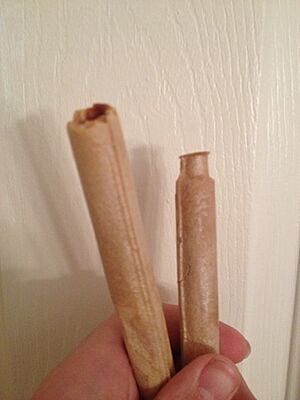
Chile has many different kinds of cakes, and home baking is very popular. Most Chilean desserts and sweets include dulce de leche, which is called manjar in Chile.
- Alfajor: A cookie filled with manjar.
- Tortas: Layered sponge cakes filled with whipped cream, pastry cream, manjar, and fruit. These are common for birthdays.
- Queques: A heavier, drier cake, usually covered in icing sugar.
- Pasteles: Like a torta but smaller and often square.
- Tartaletas: Small pies topped with fruit.
- Cuchuflí: A spongy pastry tube filled with manjar.
- Berlines: A type of doughnut.
- Kuchen: German cakes.
- Pie de Limon: Lemon pie.
See also
 In Spanish: Gastronomía de Chile para niños
In Spanish: Gastronomía de Chile para niños


